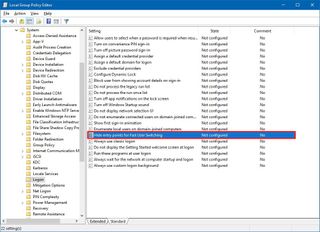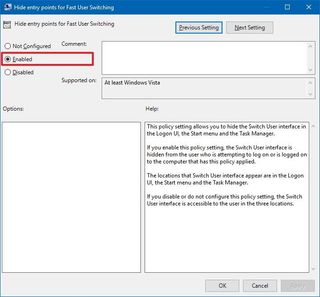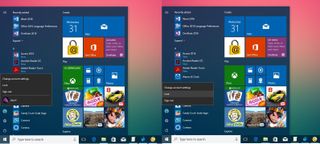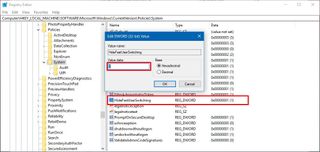How to disable Windows 10's 'Fast User Switching' feature
You can remove the option of quickly switching user accounts on Windows 10. Here's why you might want to, and how to do it.

In Windows 10, "Fast User Switching" is a useful feature, and its primary purpose is to offer a way to quickly switch from one account to another while keeping the previous user signed in. Although it's a convenient option to have on a shared computer, Fast User Switching has a few caveats. For example, while users are still signed in, you can't turn off the device, because they may lose their unsaved work. In addition, signed in accounts still consume system resources (processor, memory, and disk), and depending on the computer's hardware, running apps and services when you have multiple accounts running simultaneously can slow down the user experience.
If you find that Fast Users Switching isn't a feature you want available when sharing a computer, Windows 10, lets you disable the feature using the Local Group Policy editor and the Registry.
In this Windows 10 guide, we walk you through the steps to disable Fast User Switching.
- How to disable Fast User Switching using Group Policy
- How to disable Fast User Switching using Registry
How to disable Fast User Switching using Group Policy
In Windows 10 Pro or Enterprise, the easiest way to disable Fast User Switching is using the Local Group Policy Editor.
To disable Fast User Switching using Group Policy, do the following:
- Use the Windows key + R keyboard shortcut to open the Run command.
- Type gpedit.msc and click OK to open the Local Group Policy Editor.
- Browse the following path:
Configuration > Administrative Templates > System > Logon - On the right side, double-click the Hide entry points for Fast User Switching policy.

- Select the Enabled option.

- Click Apply.
- Click OK.
Once you complete these steps, you'll need to restart your computer. Moving forward, the user profile menu on Start will no longer show the ability to use Fast User Switching. Users will also be forced to save their work and sign out in order to allow another person to sign in.

You can always revert the changes by following the instructions mentioned above, but on step No. 5, select the Not Configured option.
Get the Windows Central Newsletter
All the latest news, reviews, and guides for Windows and Xbox diehards.
How to disable Fast User Switching using Registry
If you're running Windows 10 Home, you won't have access to the Local Group Policy Editor, but you can still disable the Fast User Switching feature by modifying the Registry.
Warning: This is a friendly reminder that editing the registry is risky, and it can cause irreversible damage to your installation if you don't do it correctly. We recommend making a full backup of your PC before proceeding.
To disable Fast User Switching using the Registry, do the following:
- Use the Windows key + R keyboard shortcut to open the Run command.
- Type regedit, and click OK to open the Registry.
- Browse the following path:
HKEY_LOCAL_MACHINE\SOFTWARE\Microsoft\Windows\CurrentVersion\Policies\System- Quick Tip: Starting with the Windows 10 Creators Update, you can copy and paste the path in the Registry's address bar to quickly jump to the location without having to browse each key.
- Right-click on the right side of System, select New and click on DWORD (32-bit) Value.

- Name the key HideFastSwitching and press Enter.
- Double-click the newly created DWORD and set the value from 0 to 1.

- Click OK.
After completing these steps, you'll need to reboot your device, and then moving forward the user profile menu on Start will no longer show the ability to use Fast User Switching. Users will also be forced to save their work and sign out before another person can sign in.
If you need to re-enable the feature, you can use the same instructions, but on step No. 4, double-click the HideFastSwitching DWORD and change its value from 1 to 0. Alternatively, you can simply right-click HideFastSwitching and select Delete to remove the item.
Wrapping things up
It should be noted that using these instructions, you're actually only removing the option to switch to user accounts in the Start menu, Sign in screen, and Task Manager, the feature will continue to be available on Windows 10. However, users won't have access to it forcing them to save their work and sign out before another person can sign in.
We focused on Windows 10 in this guide, but Fast User Switching has been around for a long time, and it's also possible to use the same instructions on Windows 8.1 and Windows 7 computers.
More Windows 10 resources
For more help articles, coverage, and answers to common questions about Windows 10, visit the following resources:
- Windows 10 on Windows Central – All you need to know
- Windows 10 help, tips, and tricks
- Windows 10 forums on Windows Central
Mauro Huculak is technical writer for WindowsCentral.com. His primary focus is to write comprehensive how-tos to help users get the most out of Windows 10 and its many related technologies. He has an IT background with professional certifications from Microsoft, Cisco, and CompTIA, and he's a recognized member of the Microsoft MVP community.

